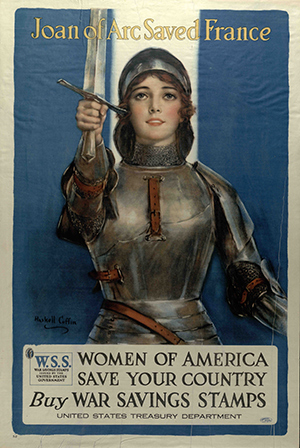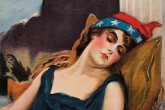Remembering the First World War
HGARC exhibition recalls sacrifice, technology, tragedy

“Wake Up, America” by James Montgomery Flagg, dated 1917, from the Robert Thornburg collection. Photos courtesy of the Howard Gotlieb Archival Research Center
BU’s illuminating new exhibition Ardent for Some Desperate Glory: Remembering the First World War recalls the patriotism, sacrifice, and loss that marked World War I. The Howard Gotlieb Archival Research Center (HGARC) show takes its title from a line in the Wilfred Owen poem “Dulce et Decorum Est,” a harrowing description of a soldier witnessing another soldier being poisoned by gas. Owen, considered the most influential of the poets who fought in the war, died in battle just a week before the Armistice was signed in November 1918. A letter by him, written while he was a second lieutenant in the Manchester Regiment, is among the many artifacts on display.
The show includes 50 posters, culled from the more than 600 World War I posters in the HGAC collection. Because of the frail condition of many of the posters, the originals had to be scanned. The reproduced posters float from the ceiling with a kind of monumental majesty. There is a grandeur about these posters, which were used as propaganda and designed both to inspire men to enlist and to urge civilians to do their part to support the war effort. One striking poster proclaims “Wake Up, America! Civilization Calls Every Man, Woman, and Child!” Recruitment posters entice young men to join the armed forces. “Be a man and do it” exhorts a US Navy poster, while another, showing a US Marine with a cocked pistol, exclaims, “First in the Fight—Always Faithful. Be a U.S. Marine.”
The posters are a reminder of the sacrifices that everyone was called upon to make. One of the most striking images is a poster of Joan of Arc in full battle armor, with the words “Women of America, Save Your Country. Buy War Savings Stamps.” Others call on civilians to plant and raise their own vegetables to help feed soldiers overseas, engage in teamwork, eat only what they need, and save food for the fighters. Even children were expected to participate. One poster shows a toddler saluting, with a slogan below urging “Little Americans Do Your Bit. Eat corn meal mush, oatmeal-corn flakes, hominy and rice with milk. Eat no wheat cereals. Leave nothing on your plate.”

“Joan of Arc Saved France” by Haskell Coffin, dated 1918, from the Robert Thornburg Collection.
“The goal was to show posters demonstrating many issues of the time, as well as to display manuscript material depicting the major upheaval in the world during the Great War and the fortitude, sacrifice, and ingenuity of those who fought it,” says HGARC director Vita Paladino (MET’79, SSW’93). “There is an unambiguous call to action, for the individual to give him- or herself to the community. To a contemporary audience that no longer trusts large institutions, especially the government, as it once did, there is something almost quaint about this message. But a visitor can see the moral imperatives of duty, honor, and self-sacrifice for a just cause still visible after 100 years have passed.”
The exhibition has a timeline of the war, beginning with the assassination of Austrian Archduke Franz Ferdinand and his wife, Sophie, in Sarajevo in August 1914 and concluding with the signing of the Treaty of Versailles by German delegates and the Allies on June 28, 1919.
One of the exhibition’s most moving parts is a series of letters, photos, and ephemera that chronicle the life—and death—of two soldiers, one British, one American. Lucas King grew up in an upper-class British family. Raised in India, he joined the King’s Royal Rifle Corps there before being sent to the front lines. In an August 10, 1914, letter to his father, he chronicles a 46-mile march carried out over 22 hours. In another, dated January 7, 1915, he writes “We have been crouching in the kitchen of a ruined chateau. Shells bursting all around.” King was killed May 8, 1915, at Ypres.
American Vinton Dearing was the only child of prominent Methodist missionaries and grew up in Japan before moving to Cambridge, Mass. He fought in the Battle of Cantigny in May 1918, the first American offensive of the war. A month later he died in the Second Battle of the Marne. Dearing left a letter to be opened by his mother in the event of his death, informing her of his financial assets. He instructs her “not to shed a tear but rejoice that you had a son to give.” Also included is his mother’s diary, opened to the page where she recorded her reaction to news of his death. The page bears a simple inscription: “The most terrible day of my life. News of my hero—killed in action.” Mary Dearing, an early members of the BU Women’s Council, outlived her son by 45 years and left her papers to the Gotlieb Center.

Newspaper clipping announcing the death of Army Lieutenant Vinton Adam Dearing on July 18, 1918. He was just 23.
Among the Dearing materials are the two bullets believed to have killed him, kept by his mother for the rest of her life. “Whenever I see them, I’m always struck by how such small things can bring an entire lifetime to an end,” says Paladino. “I wonder at the emotional courage it took Mary Dearing to keep these bullets as a constant reminder of her son’s sacrifice in the Great War.”
Other exhibition materials honor the work of American and British nurses during the war. Among them are photographic scrapbooks and an original letter by Edith Cavell, a British nurse who served in Belgium and was executed by a firing squad after helping approximately 200 Allied soldiers escape from German-occupied Belgium.
“The mechanized, merciless nature of warfare in the Great War often made individual acts of bravery and heroism among the soldiers irrelevant or even impossible,” says HGARC assistant director of manuscripts Ryan Hendrickson (UNI’98). “Given these harsh conditions, the wartime nurses stand out for their nobility, dedication, and self-sacrifice.”
Ardent for Some Desperate Glory also notes the extraordinary technologies that emerged during the war. Zeppelins, planes, tanks, and submarines all became agents of warfare for the first time, transforming forever the way combat is carried out.
The exhibition concludes with several images of African American soldiers who fought in what came to be known as “the war to end all wars.” Those images recall a largely overlooked contribution to American history. “Many Americans don’t even realize that African Americans served as combat troops in World War I,” says Hendrickson. “But their service had long-lasting consequences to race relations in the United States. The brave service of these soldiers in France cemented a Franco-African-American relationship that became a vital part of Jazz Age culture.” In the United States, however, many black veterans who returned home were lynched by white mobs after wearing their Army uniforms in public. “These lynchings,” says Hendrickson, “became a national scandal and helped inspire the great migration northward of Southern African Americans.”
The Gotlieb show coincides with two similar, equally fascinating World War I poster exhibitions currently on view in Boston. The Museum of Fine Arts show Over There! Posters from World War I features 50 patriotic posters from the United States, Britain, France, Russia, and Germany, many not exhibited since 1938. The Boston Athenaeum’s Over Here: World War I Posters from around the World includes highlights from its collection of approximately 1,800 posters related to the Great War.
The Howard Gotlieb Archival Research Center exhibition Ardent for Some Desperate Glory: Remembering the First World War is on view for a limited time in the Gotlieb Gallery and in the Richards-Frost Room on the first floor of Mugar Memorial Library, 771 Commonwealth Ave., Monday through Friday from 9 a.m. to 4:30 p.m.
2 Comments










If this exhibit opens up at all on the weekends or off hours, please post. Would love to see this, but am working.
Unfortunately, the only part of the exhibit that is open on weekends is the collection of posters in the Gotlieb Memorial Gallery is open during regular business hours on the weekend but the Richards-Frost room is only open during the week and closes at 4:15 p.m.